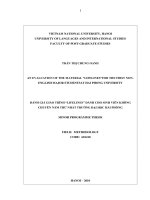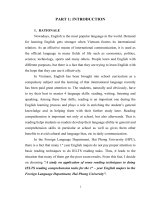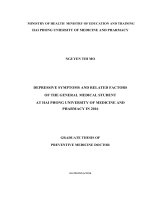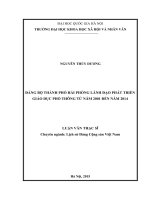- Trang chủ >>
- Sinh học lớp 10 >>
- Phân bào
hai phong university of medicine pharmacy nguyen duc tho research the copd status and effectiveness of health education campaign at kien thiet and kien bai commune hai phong city 2014
Bạn đang xem bản rút gọn của tài liệu. Xem và tải ngay bản đầy đủ của tài liệu tại đây (466.21 KB, 27 trang )
<span class='text_page_counter'>(1)</span><div class='page_container' data-page=1>
<b>HAI PHONG UNIVERSITY OF MEDICINE PHARMACY </b>
<b>NGUYEN DUC THO </b>
<b>RESEARCH THE COPD STATUS AND EFFECTIVENESS OF </b>
<b>HEALTH EDUCATION CAMPAIGN AT KIEN THIET AND </b>
<b>KIEN BAI COMMUNE, HAI PHONG CITY 2014 – 2016 </b>
<b>SPECIALITY: PUBLIC HEALTH </b>
<b>CODE: 62 72 03 01 </b>
<b>SUMMARY OF PUBLIC HEALTH Ph.D. DISSERTATION </b>
</div>
<span class='text_page_counter'>(2)</span><div class='page_container' data-page=2>
<b>Haiphong University of Medicine and Pharmacy </b>
<i><b>Advisors: </b></i>
<b>1. Assoc. Prof. Ph.D. Dao Quang Minh </b>
<b>2. Assoc. Prof. Ph.D. Tran Quang Phuc </b>
<b>Reviewer 1: </b>
<b>Reviewer 2: </b>
<b>Reviewer 2: </b>
The dissertation will be protected at the University Dissertation
Committee ... hour ... day ... month ... 2018
The information from this dissertation can be found at:
1. National Library
</div>
<span class='text_page_counter'>(3)</span><div class='page_container' data-page=3>
<b>1. RATIONALE </b>
Chronic obstructive pulmonary disease (COPD) is a common and
increased tendency. It usually occurs at the age of 40 and over, the
main risk factors are smoking, environmental pollution. The common
symptoms are dyspnea, chronic cough, and sputum production.
Spirometric measurement is used to confirm COPD diagnosis [70]
[71]. The proportion of undiagnosed COPD is rather high [40] [41]
[100] [122] [135]. The knowledge, attitude, practice (KAP) on COPD
of people is still limited [18]. Health education intervention (HEI) in
the community helps people and patients to improve KAP about
COPD. The detection and improvement of KAP for them on COPD
is very necessary. Smoking is the most common risk factor of the
COPD. Therefore, we select the tobacco growing commune as the
location for HEI with the following objectives:
1. To determine the prevalence and factors related to COPD at Kien
Thiet commune, Tien Lang district and Kien Bai commune, Thuy
Nguyen district, Hai Phong from October 2014 to April 2015.
2. To describe the status of knowledge, attitudes of people, and
practices of patients with COPD at Kien Thiet and Kien Bai
commune from October 2014 to April 2015.
3. To evaluate the effectiveness of health education campaign with
regards to the COPD at Kien Thiet commune after one-year of
intervention.
<b>2. Scientific contributions </b>
</div>
<span class='text_page_counter'>(4)</span><div class='page_container' data-page=4>
newly diagnosed. Of the 17 COPD patients (5,5%) with no symptoms
were only detected by spirometry.
- Health education intervention in the community helped to improve
people’s KAP about COPD significantly. The model of COPD Club
activities was easy to implement with low investment but had
positive effects: patients could do self-care and respiratory
rehabilitation at home and knew how to use the inhaler techniques.
Health status was improved (reflected in the criteria for reducing
means of exacerbation, mMRC, and CAT). The classification of
airflow limitation severity and GOLD ABCD assessment of patients
had little change.
<b>3. Dissertation outline </b>
Consisting of 124 pages: Introduction: 02 pages; Overview: 30 Pages;
Subjects and methods: 18 pages; Study diagram 01 page; Results: 35
pages; Discussion: 35 pages; Conclusions: 02 pages;
Recommendations: 01 page; There are 37 tables; 22 pictures; 180
references: 25 documents in Vietnamese and 155 in English
<b>Chapter 1 </b>
<b>OVERVIEW </b>
</div>
<span class='text_page_counter'>(5)</span><div class='page_container' data-page=5>
<b>1.2. Epidemiology of the chronic obstructive pulmonary disease </b>
In 1990, the number of deaths attributable to COPD was sixth,
projecting that by 2020 it would rank third in all causes of death
globally [89]. In 2016 the world was estimated to have 251 million
people with COPD, by 2015 about 3.17 million people died from it,
and 90% were in low- and middle-income countries [173]. Mortality
has increased in the last 30 to 40 years. Recent mortality in some
countries tends to be lower for males, and for females to stabilize or
increase [42]. The use of spirometry for the diagnosis of COPD can
detect double the number of patients compared to the detection of the
disease based on the questionnaire [86]. The prevalence of COPD in
people aged 40 years or older in Vietnam ranges from 3% to 8.1% [5]
[10] [13] [15] [16] [17] [25] [127].
<b>1.3. Factors related to chronic obstructive pulmonary disease </b>
The most important risk factors for COPD is smoking; besides,
factors such as dust, occupational chemicals, air pollution also play
an important role. Antitrypsin deficiency, gender, infection, climate,
asthma in history, etc... are also related to COPD [39] [42] [46] [44]
[51] [67] [68] [70] [72] [108] [126].
<b>1.4. Clinical features, spirometry, and COPD diagnosis </b>
</div>
<span class='text_page_counter'>(6)</span><div class='page_container' data-page=6>
<b>1.5 Knowledge, attitude, and practice of COPD </b>
Many studies have found that people do not often know the name of
the disease, the causes, the prevention, the harm of smoking, and are
confused with other lung diseases. Patients do not often use the
inhaler techniques or have not been instructed about respiratory
rehabilitation [18] [29] [82] [105] [129] [140] [164].
<b>1.6. Health education communication intervention about COPD </b>
Health education intervention about COPD equips people with KAP
on the disease. The goal is to reduce the incidence and burden of the
disease. Education about knowledge can be the causes, symptoms,
preventions, place of examination and treatment, and the harm of
smoking; attitudes when they or their relatives have the COPD. Care
gaps between the patient and the respiratory specialist are mainly due
to different perceptions about the disease [138]. Health education
programs can provide to patients with easy access to medicines,
spirometry and cost savings [123]. The intervention significantly
reduced the frequency of exacerbations and improved health status
when compared with the control group [180]; Overcome the false of
inhaler using [63]. The benefits of pulmonary rehabilitation include
decreased dyspnea and improved health [158]. Home pulmonary
rehabilitation may apply to COPD patients who do not access to
rehabilitation center [33].
<b>Chapter 2 </b>
<b>SUBJECTS AND METHODS </b>
<b>2.1. Research subjects </b>
</div>
<span class='text_page_counter'>(7)</span><div class='page_container' data-page=7>
- Interventions on the same subjects at Kien Thiet commune consists
of 2,206 people including 139 patients.
- Selection criteria: people 40 years and older living more than 5
years in two communes have mental health to answer the
questionnaire and are voluntary to participate in the research.
- Confirm COPD diagnosis: Spirometry is required to make the
diagnosis; the presence of a post-bronchodilator the Gaensler (FEV1
/ FVC) < 70% confirms the presence of airflow limitation [12] [70]
[71] [72]. Bronchodilator applies to all subjects with airway
limitation. These subjects inhale 400 g Salbutamol within 6 minutes
and measure FEV1 after 20 minutes. The post-bronchodilator, FEV1
increase < 200ml and/or under 12% and The Gaensler < 70% to
confirm COPD.
- Diagnosis of chronic bronchitis: patients have a persistent cough
continuously at least 3 months in a year and at least two consecutive
years and have no airflow limitation.
- Diagnosis of asthma: patients with a history of asthma.
Measurement of ventilation function, the post-bronchodilator, FEV1
increases > 200ml and/or ≥ 12% and The Gaensler ≥ 70% to confirm
asthma.
- Eligibility criteria: people having mental disorders, temporary
residence, temporary absence and living in communes under 5 years.
Subjects can not measure ventilation function due to throat
malformations, heart failure, goiter level III, etc... or do not agree to
participate in research.
<b>2.2. Time of the study: from oct 2014 to dec 2016. </b>
</div>
<span class='text_page_counter'>(8)</span><div class='page_container' data-page=8>
<b>2.4. Research methodology </b>
<b>2.4.1. Research design </b>
- A cross-sectional study: to research epidemiology and KAP of
people and patients about COPD.
- Interventional study: One - year of HEI to improve KAP for
population, especially focus on the education at COPD Club with the
aim of improving practice, health status and respiratory function for
COPD patients.
<b>2.4.2. Sample size and sampling technique </b>
<b>- Sample size for the prevalence [22]: n = Z2</b>
<b>1- α/2 p(1-p)/ (p.)2 </b>
<b>Z1-α/2 = 1.96 ; p = 0.057 [5] [25] ; = 0.2. </b>
Because of studying in two communes so We take DE to be 2. We
calculated sample size: n = 5,196. In fact that we selected all subjects
40 years old and over in two communes and get 5,220 subjects.
- Intervention size [22]:
<b>n = Z2</b>
<b>(α,β)[p1 (1 - p1) + p2 (1 – p2)] / (p1 – p2)2 </b>
p1: good knowledge about COPD before intervention estimates 5%.
p2: good knowledge about COPD after intervention reaches 20%.
Z2<sub>(α, β) = 10.5 (table Z with α=0.05; β =0.10). Calculate n = 97. </sub>
All research subjects before the intervention are selected. We receive
2206 people, including 139 patients.
<b>2.4.3. Variables and Method of data collection </b>
</div>
<span class='text_page_counter'>(9)</span><div class='page_container' data-page=9>
and high school+. Occupations: farmer, worker, staff, retire, free
work. Symptoms: chronic cough, dyspnea, sputum production.
- Chronic bronchitis, asthma, pulmonary tuberculosis in history.
- The smoking status: We calculated and converted into pack-years
(P-Ys). P-Ys is the number of cigarette packs (one including 20
cigarettes) smoked a day multiply with the number of years smoked
[10] [53]. Convert from pipe tobacco to cigarette: 1 cigarette = 1
gram of pipe tobacco = 5 times as much as 1/20 P-Ys.
- Fuels used in the kitchen: gas, coal, firewood, straw, etc. The
exposure time is calculated based on the number of years of using.
-The prevalence of COPD and newly diagnosed. The prevalence of
COPD and related categories by ages, sex, education, smoking status.
- The COPD prevalence according to clinical symptoms and a history
of respiratory disease. Characteristics of patients: smoking,
obstructive airway obstruction, and COPD stage assessment.
- Knowledge of COPD has 15 questions, including 25 correct
answers, good knowledge if there are 18 correct answers or more.
Included knowledge is the name, cause, symptoms, characteristics,
drugs, and prevention.
- The attitudes towards COPD have five questions, including 11
correct answers, good attitude if there are 8 correct answers or more:
attitude if you or people around have COPD, if people smoke, about
living and activities with COPD patient.
</div>
<span class='text_page_counter'>(10)</span><div class='page_container' data-page=10>
- Assessment of symptoms by mMRC and health status by the COPD
Assessment Test (CAT).
- Classification of airflow limitation severity base on FEV1%
predicted [70] [72]. GOLD 1 (mild): FEV1 ≥ 80%; GOLD 2
(moderate): 50% ≤ FEV1 < 80%; GOLD 3 (severe): 30% ≤ FEV1 <
50%; GOLD 4 (very severe): FEV1 < 30 % predicted.
- GOLD ABCD assessment (GOLD-2017) base on exacerbations,
mMRC, and CAT [72].
<b>2.4.4. Research steps </b>
- Interview the epidemiology and KAP on COPD, screening and
measure ventilation function for subjects with symptoms or risk
factors.
- Intervention network: the author and local health staffs do directly
with the coordination of the commune authorities.
- Training on communication skills, KAP, diagnosis, and treatment of
COPD for health workers and make the communication materials.
- Indirect communicate by loudspeakers of villages and communes
and hand out leaflets to each household. Communicate directly at the
COPD Club once a month. Participants are educated about KAP and
issues related to COPD. Guide to quit smoking, practice breathing
exercises, cough control, use the inhale techniques.
- Evaluate after intervention about KAP, re-measure of ventilation
function for patients.
<b>- Intervention Efficiency (IE): IE% = (│p2 – p1│/p1)100%. </b>
p1: value proportion before the intervention. p2: value proportion
after the intervention. Practice assessment by checklist.
</div>
<span class='text_page_counter'>(11)</span><div class='page_container' data-page=11>
<b>2.6. Ethics in research: The dissertation was approved by Haiphong </b>
University of Medicine and Pharmacy. The study was approved by
the local government and health authorities. Participants are
voluntary in research and are kept confidential. All patients are
consulted about their diseases and honesty of the researcher.
<b>Chapter 3 </b>
<b>RESULTS </b>
<b>3.1. Prevalence and factors related to COPD </b>
<b>Table 3.5. COPD prevalence of the subjects </b>
<b>Subjects </b>
<b>Commue </b>
<b>Total </b>
<b>(n = 5220) </b>
<b>COPD </b>
<b>(n = 310) </b> <b>% </b> <b>p </b>
Kien Thiet 2540 177 7.0
< 0.01
Kien Bai 2680 133 5.0
Total 5220 310 5.9
<i><b>Comments: prevalence of COPD was 5.9% (Kien Thiet 7.0% vs </b></i>
Kien Bai 5.0%).
91.3%
8.7%
Newly diagnosed
Already diagnosed
<b>Picture 3.4. Diagnosed status of COPD patients (n = 310) </b>
<i><b>Comments: there were 283/310 (91.3%) new COPD patients </b></i>
</div>
<span class='text_page_counter'>(12)</span><div class='page_container' data-page=12>
<b>Tabe 3.6. Relation between prevalence of COPD to the gender of </b>
<b>subjects (n = 5220) </b>
<b>Subjects </b>
<b>Sex </b>
<b>Total </b>
<b>(n = 5220) </b>
<b>COPD </b>
<b>(n = 310) </b> <b>% </b>
<b>OR </b>
<b>(95%CI) </b> <b>p </b>
Male 2326 202 8.7 2.45
(1.9-3.1) < 0.01
Female 2894 108 3.7
Total 5220 310 5.9
<i><b>Comments: proportion of COPD in male is 8.7% and female is 3.7%. </b></i>
Men increased the risk of having COPD by 2.45 (1.9-3.1) times to
compare with women.
1.9%
3.8%
9.5%
13.3%
0
2
4
6
8
10
12
14
40 to 49 50 to 59 60 to 69 ≥ 70 years old
<b>Picture 3.6. Relation between prevalence of COPD with ages of </b>
<b>subjects (n = 5220) </b>
<i><b>Comments: prevalence of COPD tends to increase with age, lowest </b></i>
</div>
<span class='text_page_counter'>(13)</span><div class='page_container' data-page=13>
<b>Table 3.8. Relation between prevalence of COPD to smoking of </b>
<b>subjects </b>
Smoking
status
Subject
(5220)
COPD (310)
OR (95%CI) p
n %
Non smoking 3051 110 3.6 ref
Smoking 2169 200 9.2 2.72 (2.14-3.45) < 0.001
Waterpipe 1221 122 10.0 2.97 (2.27-3.88) < 0.001
Cigarette 472 36 7.6 2.21 (1.50-3.26) < 0.001
Two kinds 476 42 8.8 2.59 (1.79-3.74) < 0.001
<i><b>Comments: smoking affected COPD by 2.72 (2.14-3.45) times than </b></i>
the non-smoking. Overall Waterpipe or Cigarette smoking all
affected COPD.
<b>Picture 3.7. Relation between prevalence of COPD to smoking </b>
<b>levels of subjects (n = 5220) </b>
<i><b>Comments: The prevalence of COPD tends to increase with the </b></i>
</div>
<span class='text_page_counter'>(14)</span><div class='page_container' data-page=14>
<b>Picture 3.10. Prevalence of COPD among subjects with </b>
<b>respiratory symptoms </b>
<i><b>Comments: The proportion of COPD is high in subjects with cough, </b></i>
dyspnea, sputum symptoms. Subjects with above chronic symptoms
should measure ventilation function to detect COPD.
<b>Hình 3.12. Air limitation clacification of COPD patients </b>
<i><b>Comment: COPD patients having mild and moderate obstructive </b></i>
</div>
<span class='text_page_counter'>(15)</span><div class='page_container' data-page=15>
<b>3.2. Knowledges, attitudes, practices of subjects before </b>
<b>intervention </b>
<b>Table 3.14. Knowledge of subjects about COPD symptoms </b>
Subjects
Knowledge
Total
(n = 5220)
COPD1
(n = 310)
Non COPD2
(n = 4910) p
(1&2)
n % n % n %
Cough 2075 39.8 121 39.0 1954 39.8 > 0.05
Sputum 1093 20.9 52 16.8 1041 21.2 > 0.05
Dyspnea 1883 36.1 120 38.7 1763 35.9 > 0.05
3 symptoms 689 13.2 30 9.7 659 13.4 > 0.05
Unknown 2614 50.1 145 46.8 2469 50.3 > 0.05
<i><b>Comments: knowledge of people about COPD symptoms is poor. </b></i>
<b>Table 3.15. Knowledge of subjects about the causes of COPD </b>
Subject
Knowledge
Total (5220) COPD1 <sub>Non COPD</sub>2 <sub>P </sub>
(1&2)
n % n % n %
Smoking 2280 43.7 136 43.9 2144 43.7 > 0.05
EP1 <sub>1861 </sub> <sub>35.7 115 37.1 1746 </sub> <sub>35.6 </sub> <sub>> 0.05 </sub>
OD2 <sub>787 </sub> <sub>15.1 </sub> <sub>41 </sub> <sub>13.2 </sub> <sub>746 </sub> <sub>15.2 </sub> <sub>> 0.05 </sub>
Genetic factor 608 11.6 23 7.4 585 11.9 < 0.05
Unknown 2471 47.3 137 44.2 2334 47.5 > 0.05
<i>(EP1<sub>: Environmental pollution; OD</sub></i>2<i><sub>: Occupation dust) </sub></i>
<i><b>Comments: 43.7% of subjects knew smoking was the cause of </b></i>
</div>
<span class='text_page_counter'>(16)</span><div class='page_container' data-page=16>
<b>Table 3.19. Attitudes of subjects when they know they have </b>
<b>COPD </b>
Subject
Attitudes
Total (5220) COPD1 <sub>Non COPD</sub>2 <sub>p </sub>
(1&2)
n % n % n %
Quit smoking 2052 39.3 125 40.3 1927 39.2 > 0.05
Avoid dust 1241 23.8 54 17.4 1187 24.4 < 0.01
Breath exercises 785 15.0 45 14.5 740 15.1 > 0.05
Cold prevention 1190 22.8 65 21.0 1125 22.9 > 0.05
<i><b>Comments: overall attitudes of subjects when they knew about </b></i>
<b>COPD was not good. Only 39.3% of smokers would quit smoking. </b>
<b>3.3. Effect of health education communication to COPD after the </b>
<b>one-year intervention </b>
<b>Table 3.26. Knowledge of subjects about the causes and </b>
<b>symptoms of COPD before and after intervention </b>
Intervention
Knowledge
Before (2206) After (2206)
p I-E
(%)
n % n %
<b>Causes </b>
Smoking 956 43.3 1960 88.8 < 0.001 105.1
EP1 <sub>800 </sub> <sub>36.3 </sub> <sub>1715 </sub> <sub>77.7 </sub> <sub>< 0.001 </sub> <sub>114.0 </sub>
OD2 <sub>336 </sub> <sub>15.2 </sub> <sub>758 </sub> <sub>34.4 </sub> <sub>< 0.001 </sub> <sub>126.3 </sub>
Genetic factor 268 12.1 460 20.9 < 0.001 72.7
<b>Symptoms </b>
Cough 862 39.1 1609 72.9 < 0.001 86.4
Sputum 459 20.8 774 35.1 < 0.001 68.8
Dyspnea 836 37.9 1758 79.7 < 0.001 110.3
3 symptoms 312 14.1 634 28.7 < 0.001 103.5
</div>
<span class='text_page_counter'>(17)</span><div class='page_container' data-page=17>
<i><b>Comments: after the intervention, most people knew the causes of </b></i>
COPD due to smoking, environmental pollution, and symptoms of
COPD included cough, dyspnea.
<b>Picture 3.18. Knowledge, attitudes, and knowledge of the COPD </b>
<b>name of the subjects on COPD before and after the intervention. </b>
<i><b>Comments: after the intervention, the knowledge and attitude of </b></i>
people improved significantly. Most of them knew the name of the
disease.
<b>Table 3.31. The attitude of subjects when they know they have </b>
<b>COPD themselves before and after intervention </b>
Intervention
attitudes
Before
(n=2206)
After
(n=2206) p IE
(%)
n % n %
Quit smoking 845 38.3 2004 90.8 <0.001 137.1
Avoid dust 542 24.6 1607 72.8 <0.001 195.9
Breath excieses 338 15.3 724 32.8 <0.001 114.4
Cold prevention 518 23.5 1001 45.4 <0.001 93.1
Unknown 614 27.8 48 2.2 <0.001 92.1
<i><b>Comments: when having COPD, most people would quit smoking, </b></i>
</div>
<span class='text_page_counter'>(18)</span><div class='page_container' data-page=18>
<b>Table 3.33. The Practice of patients about COPD before and </b>
<b>after intervention </b>
Correct practice Before(n=139) After(n=139) p IE
(%)
n % n %
Cough control 01 0.7 104 74.8 <0.001 14,757
Breath excieses 00 0.0 102 73.4
Inhaler using 14 10.1 104 74.8 <0.001 640.6
Accuhaler using 01 0.7 64 46.0 <0.001 6,471
Turbuhaler using 0 0.0 68 48.9 <0.001
Nonsmoking 76 54.7 103 74.1 < 0.05 35.5
Correct practice 00 0.0 87 61.9
<i><b>Comments: after the intervention, most of the patients practiced </b></i>
correctly about cough control, breath and inhaler using. The
proportion of smoking reduced and 61.9% practiced correctly.
<b>Table 3.34. Result of CAT, mMRC, exacerbations last year and </b>
<b>ventilation function before and after intervention </b>
Intervention
Indexes
Before (n=139) After (n=139)
p
n % n %
mMRC ≤ 1 74 53.2 93 66.9 < 0.05
CAT < 10 26 18.7 26 18.7 > 0.05
No exacerbation 75 54.0 89 64.0 > 0.05
Means of mMRC 1.47 ± 1.07 1.17 ± 0.97 < 0.05
Means of CAT 17.69 ± 5.87 16.14 ± 4.88 < 0.05
Exacerbations 0.76 ± 0.96 0.52 ± 0.81 < 0.05
Means of FEV1% 59.96 ± 22.13 58.33 ± 22.12 > 0.05
<i><b>Comments: after the intervention, means of CAT, mMRC, </b></i>
</div>
<span class='text_page_counter'>(19)</span><div class='page_container' data-page=19>
<b>Chapter 4 </b>
<b> DISCUSSION </b>
<b>4.1. Prevalence and relative factors to COPD </b>
</div>
<span class='text_page_counter'>(20)</span><div class='page_container' data-page=20></div>
<span class='text_page_counter'>(21)</span><div class='page_container' data-page=21>
have shown that smoking is closely related to COPD [5] [16] [31] [37]
[115] [178]. Subjects who were exposed to kitchen smoke > 30 years
had more risk of COPD than those having no exposure or less
exposure, OR = 7.35 (1.0-53.4); p < 0.05. Many studies also show
that kitchen smoke exposure affected COPD [120] [145] [179]. To
minimize the effects of kitchen smoke on COPD, the place of
cooking should be ventilated or the clean fuel should be used. Results
showed that 66.4% of COPD patients were at mild and moderate
airflow limitation stage. Our study result was the same to study about
COPD epidemiology of Ngo Quy Chau; Douglas W Mapel, the
COPD patients were often at the stage of mild and moderate
obstruction [4] [56]. Among 310 COPD patients, there were 17
patients with no symptoms (5.5%) only detected by spirometry.
<b>4.2. Knowledge, attitude, and practice about the COPD </b>
</div>
<span class='text_page_counter'>(22)</span><div class='page_container' data-page=22>
interview, 42.9% of the respondents said that no smoking was the
way of prevention. If they got COPD, 39.3% of subjects would quit
smoking; 23.8% avoided dust or chemical. Because knowledge about
the causes and symptoms was poor, the people didn’t know how to
prevent the disease and didn’t have the right attitude. Before the
intervention, no patient had practiced correctly about COPD. Most of
the patients did not know how to do breathing exercise, cough control
and use of inhaler techniques. Many studies also found that patients
practiced incorrectly about COPD [63] [105].
<b>4.3. Effect of health education communication to COPD after </b>
<b>one-year of intervention </b>
</div>
<span class='text_page_counter'>(23)</span><div class='page_container' data-page=23>
improve their knowledge of the causes, symptoms, and preventions
on COPD. We educated patients about breathing exercises, cough
control, smoking cessation, how to use some inhale techniques and
detect the exacerbations, etc. Results showed that the correct practice
of patients increased from zero to 61.9% after HEI. The proportion of
patients practiced correctly cough control accounting for 74.5%;
breathing 73.4%; inhale techniques using 74.8%. Some patients who
practiced incorrectly were elderly or weak patients, so they need
support from relatives or healthcare workers. The proportion of
smokers reduced from 45.3% to 25.9%. Among smokers, the
proportion of those already quitting smoking was 42.9% and those
who reduced smoking was 46%. Because of planting tobacco
commune, smoking is a habit difficult to remove, so it is necessary to
communicate continuously about smoking cessation for patients.
Studies on the effectiveness of HEI to patients worldwide have also
achieved different results depending on the kind of intervention [62]
[104] [155] [170]. Respiratory rehabilitation aims to improve the
health and ventilation function of COPD patients [91] [106] [110]
[144]. After HEI, means of mMRC reduced (1.47 ± 1.07 vs 1.18 ±
0.97); exacerbation (0.76 ± 0.96 vs 0.52 ± 0.81); CAT (17.69 ± 5.87
vs 16.14 ± 4.88) significantly, p < 0.05. The classification of airflow
limitation severity and GOLD ABCD assessment of patients changed
negligibly. Research showed that the activities of COPD Club at the
commune was easy for patients to participate, bring a positive effect
on improving health status, minimizing declined respiratory function
and improving the quality of life for people with COPD.
</div>
<span class='text_page_counter'>(24)</span><div class='page_container' data-page=24>
- Selection of the epidemiological sample was not representative of
the population.
- The research focused on determining the prevalence, KAP
intervention for COPD, so it did not mention other characteristics of
clinical and subclinical characteristics such as organ symptoms, other
diseases X-ray, etc…
+ No relation was found between passive smoking and COPD due to
rural characteristics of waterpipe, people directly processing or using
so it is difficult to evaluate that. We could not intervene to change the
planning of waterpipe tobacco to the other economic forms.
- We did not evaluate the smoking situation of people after the
intervention.
<b>CONCLUSIONS </b>
<i><b>After studying the epidemiology and KAP on COPD at Kien Thiet </b></i>
<i><b>and Kien Bai communes, and one-year health education </b></i>
<i><b>intervention at Kien Thiet commune, we had some conclusions: </b></i>
<b>1. Prevalence and factors related to chronic obstructive </b>
<b>pulmonary disease </b>
- The prevalence of COPD in population 40 years old and over was
5.9% (Kien Thiet 7.0% and Kien Bai 5.0%). Men increased the risk
of having COPD by 1.82 times to compare with women.
- The proportion of COPD among smokers was 2.6 times higher than
non-smokers (9.2% vs 3.6%; p < 0.001).
- With ≥ 10 P-Ys of smoking, waterpipe smoking effected on COPD
4.88 times more than cigarette smoking.
</div>
<span class='text_page_counter'>(25)</span><div class='page_container' data-page=25>
- Among COPD patients, there was 91.3% undiagnosed; 5.5% with
no symptoms and 66.4% at the mild and moderate obstructive stage.
<b>2. Knowledge, attitude, and practice about COPD before </b>
<b>intervention </b>
- Knowledge: good knowledge of people about COPD was 4.7%.
- 84.9% of subjects did not know the name of the disease, the
proportion of subjects knew about COPD symptoms: a cough 39.8%,
sputum 20.9%; dyspnea 36.1%.
- Only 43.7% of subjects knew the cause of the disease due to
smoking and 42.9% knew non-smoking as a preventive measure.
- Attitude: good attitude about COPD before the intervention was
16.4%. When they had the disease, 39.3% would quit smoking;
23.8% would avoid dust, chemicals.
- Practice: None of the patients practiced COPD well, most of them
did not know to use inhale techniques and respiratory rehabilitation.
<b>3. Effectiveness after one-year of HEI about the chronic </b>
<b>obstructive pulmonary disease. </b>
<b>Knowledge: good knowledge of people increased from 4.8% to </b>
27.2%; IE: 446.7%; 80.3% known COPD name, IE: 438.9%.
- The proportion of subjects knew about COPD symptoms: cough
73%; dyspnea 79.7%; sputum 35.1%; IE: 86.4%; 110.3%; 68.8%
respectively.
- The proportion of subjects who knew smoking as the cause of
COPD increased to 88.9%; IE: 105.1%. Non-smoking is COPD
prevention 88.2%; IE: 98.2%.
</div>
<span class='text_page_counter'>(26)</span><div class='page_container' data-page=26>
<b>Practice: the good practice of patients increased by 61.9%. The </b>
proportion of smoking patients decreased from 44.7% to 25.5%; IE:
43%. Among smoking patients, 42.9% had stopped and 46% reduced
smoking. Most patients practiced correctly about cough control,
breath, inhaler techniques.
<b>Health status and ventilation function of the patient: means of </b>
CAT, mMRC, exacerbation of patients last year reduced significantly.
The classification of airflow limitation severity and GOLD ABCD
assessment of patients changed negligibly.
<b>SUGGESTION </b>
1. The health system should plan, screen and measure the ventilation
functions for all subjects aged 40 and older with risk factors in the
community for early COPD detection and proper preventive
measures and treatment.
2. The health system in collaboration with the media center should
regularly do health education communication to improve knowledge
and attitude and practice for people about COPD.
</div>
<span class='text_page_counter'>(27)</span><div class='page_container' data-page=27>
<b>LIST OF RESEARCH WORKS OF THE AUTHOR THAT </b>
<b>WERE PUBLISHED RELATED TO THE THESIS </b>
1. Nguyen Duc Tho, Pham Minh Khue, Pham Thu Xanh, Tran
Quang Phuc (2017), “Knowledge, attitude and practice
toward chronic obstructive pulmonary disease among people
aged of 40 and older in two communes, Hai Phong in 2015”,
<i>Journal of Preventive Medicine, Vol. 27, No.10, Pages. </i>
11-18
2. Nguyen Duc Tho, Pham Thu Xanh, Pham Minh Khue, Tran
<i>Quang Phuc (2017), “Prevalence of chronic obstructive </i>
pulmonary disease among people aged 40 years and older in
two communes in Hai Phong”, <i>Journal of Preventive </i>
<i>Medicine, Vol. 27, No.10, Pages. 19-25 </i>
</div>
<!--links-->









